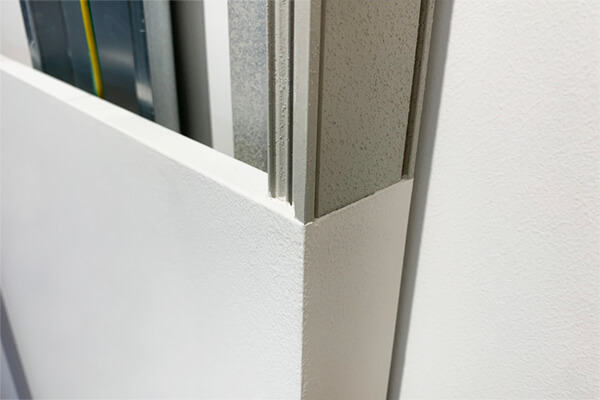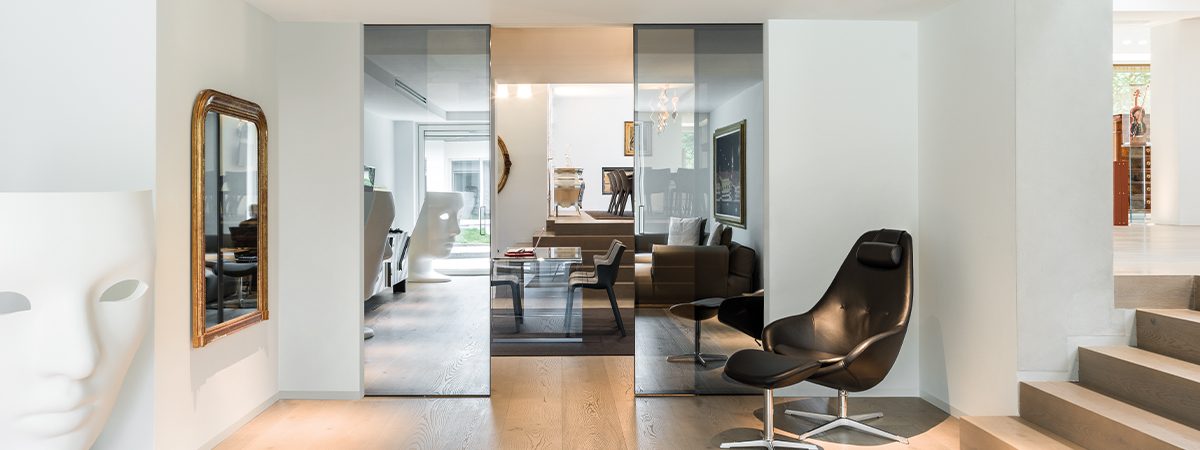How to install a pocket door
How to install a sliding pocket door system
The installation of a sliding pocket door system requires two steps: the installation of a counterframe, a metal sructure specific for plasterboard walls or masonry walls, and the mounting of the desired door panel, in wood or glass.
ECLISSE offers a wide range of sliding pocket door systems to satisfy the most different needs, designs and uses.
One of the advantages of installing a sliding pocket door which disappears inside the wall is that it allows to save useful space in your home, if compared to a traditional swing door.
This is why installing a sliding pocket door means redesigning your living and working spaces, even when you have limited space available.

ECLISSE Single counterframe - stud wall version

ECLISSE Single counterframe - stud wall version

ECLISSE Single counterframe - solid wall version

ECLISSE Single counterframe - solid wall version
Do you prefer masonry walls or plasterboard walls?
A sliding pocket door system can be used on both plasterboard walls (or stud walls) or masonry walls (or solid walls). It depends on the construction technique provided by the project and on possible present architectural constraints in the case of a renovation project.
For example, if you wish to install a sliding pocket door to divide a space into two separate room or if you want to replace ah hinged door to create a more fluid opening, choosing the open structure of our stud wall models may be the best solution, with the quickest installation times.

5 things to know when installing a pocket door system
Installing a sliding pocket door system is not difficult but requires considerable precision. Possible inconvenience that may occur for an incorrect installation is potentially very high and annoying:
malfunctioning of the door opening
rapid wear of the components
damages to the door
This is why we have patented components that allow our sliding pocket door systems to be installed in a workmanlike manner, but also to be inspected and maintained at any time after the system has been installed.
Assembly instructions are available in the Technical Support section. For any queries, please contact us.
1. The extractable track system
- PATENTED -
What happens is the track gets dirty or worn?
Thanks to this exclusive patent, it’s not necessary to knock the wall down or perform costly maintenance work. The track can can indeed be easily removed, enabling you to clean the door sliding guide, replace it with a new track or install accessories, such as the soft-closing device ECLISSE BIAS or the Self-closing system.


2. The alignment bar
- PATENTED -
To ensure a smooth sliding, the pocket must be perfectly aligned with the door stop and the whole frame must be square with the floor.
To simplify the installation, ECLISSE patented a galvanised metal sheet bar that connects the vertical bar at the bottom of the pocket to the metal door post, to obtain a stiffer structure that is easier to install. The bar must be then removed, after the installation.
3. The horizontal reinforced bars
- PATENTED -
The horizontal bars are present both in stud wall and in solid wall versions of our frames. They have different structures to satisfy different needs, but both versions improve the resistance to lateral bending. This occurs because a rigid structure is only slightly subject to wear and thus tends to last longer without altering its usability.
In almost all models, the stud wall version has patented pre-drilled bars that ease the screwing and fixing of the plasterboards.


4. Under frame tear-off profile
- PATENTED -
Both in new constructions and in renovations there may be discrepancies in height between the finished floor level and the bottom of the counterframe (already installed), being the latter at a higher level. This would result in a door that slides too high with respect to the floor, leaving a visually unpleasant slit at the bottom.
Our patented under frame tear-off profile can be removed as the ring-pull of a can, granting the installer extra space to adjust the door height.
5. Protruding knurled plaster mesh
When installing a sliding pocket door, you would never want to see unpleasant cracks on the wall.
Applying the plaster to the pocket is often complicated, because the plaster may fail to adhere to it and may slide or detach, resulting in defects and negatively impacting the correct sliding of the door, even after a long time.
Our mesh has micro-incisions, is very tight (25x50 mm) and is laid at a slight distance from the underlying metal sheet. This solution ensures the perfect adhesion of the plaster and a better final result.
Why does it protrude? To bind more easily with the wall and avoid crack along the joint.



Installing a flush sliding pocket door system
The ECLISSE Syntesis Flush Collection is synonymous with flush-to-the-wall, a range of solutions that do not entail the use of jambs, architraves or any exterior edging. Clean and refined lines that perfectly fit to modern and design-oriented settings.
The installation conditions of a frame for flush sliding doors are the same as those applied to a frame with jambs and architraves. What characterises a flush sliding pocket door system is the presence of resin-coated integrated-structured profiles: vertical reinforced bars, the top beam and the metal door stop are pre-treated with a special resin which aids adhesion of the final finishing layer, for an impeccable finishing along the whole perimeter of the doorway.

Resin-coated integrated structure
The whole doorway perimeter is pre-treated with a special resin that aids the adhesion of the final finishing layer.

Paintable gaskets for the top beam
The horizontal gaskets can be painted with the same finish as the wall and hide the track system from view.
Do you want electrical wirings to run inside the counterframe?

Sometimes, the lack of space forces to run electrical wirings on the same portion of wall that hosts the sliding pocket door counterframe. This often requires integrating it into a false wall that add thickness to the actual wall, that paradoxically takes part of the little space we are trying to save.
The ECLISSE Luce and ECLISSE Syntesis Luce counterframes are designed and patented to satisfy this particular need.
They allow the passage of electrical wiring where exactly the counterframe is installed and that in fact allows to have switches, sockets, thermostats and light points right close to the doorway. All of this without hinder the correct sliding of the door panel.
Available for both solid and stud walls, single and double door, in standard and in custom size.
A sliding pocket door and a load-bearing wall?
Have you ever tried hanging a shelf or wall units onto a wall in which a sliding pocket door slides?
We advise not to do it, as the wall is not equipped to bear excessive loads. Moreover, the screws or nails could cross the frame, enter the pocket and damage the door.
The ECLISSE Ewoluto technology was developed in collaboration with the CSI Institute to overcome this constraint. The frame becomes a real wall capable of withstanding the loads of shelves, paintings, handles and wall units. Maximum freedom to decorate your home, even when you have a limited space.


